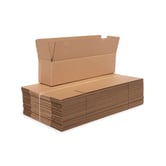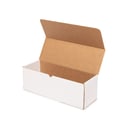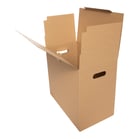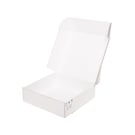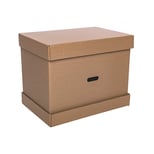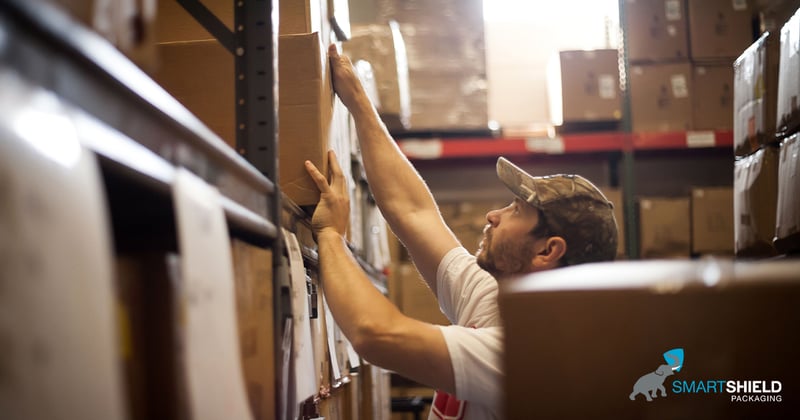Cardboard boxes are designed to protect your materials and products. They are lightweight with firm sides that can cushion impacts and cost less than other forms of shipping containers.
Choosing the Right Cardboard Box Material
There are many types of cardboard boxes on the market, allowing for packaging to be customized to your unique specifications.
With different strength, shapes, sizes, and styles, cardboard boxes offer an incredibly durable and lightweight way to fit many applications.
This article will review the most common types of cardboard used for industrial packaging and help guide you toward making the best choice for your business.
What are cardboard boxes made from?
Cardboard boxes, also known as corrugated boxes or corrugated packaging, are made of multiple layers of cellulose fibres from virgin softwood trees like pine, fir, and spruce.
Nearly all boxes in Ontario and Canada are made with 100% recycled cardboard and paper materials, depending on the box type. However, at the heart of each cardboard box are trees.
The Composition of Corrugated Boxes
.jpg?width=270&height=195&name=BOARD%20GRADES-1%20(1).jpg)
Corrugated fiberboard is composed of two main layers:
- Linerboard — flat, outer surface between one or more layers of medium.
- Flute — wavy, fluted paper in between the linerboards.
Each layer uses a special kind of heavy paper called containerboard with varying strengths depending on the thickness and style used for the liner board and medium.

Image Source: Aopack
- Single face = 1 linerboard + 1 corrugated medium with flutes exposed
- Single wall = 2 sheets of linerboard + 1 layer of corrugated medium
- Double wall = 3 sheets of linerboard + 2 layers of corrugated medium
- Triple wall = 4 sheets of linerboard + 3 layers of corrugated medium
The ‘wavy’ fluted corrugated layers glued to the linerboard give cardboard boxes their strength.
Kraft Paper
Kraft, which is German for strength, paper is made specifically from softwood trees with long fibres such as spruce, pine, or fir trees. These long fibres create tension in Kraft paper, making it tear and burst-resistant.
Depending on the trees used to make Kraft paper, its colour can vary from brown to yellow. Spruce, pine, and silver birch trees give Kraft paper a rustic brown colour.
In some cases, companies may prefer white corrugated boxes, which is achieved by using bleach on Kraft paper. However, most people stick with the original brown colour for its cost savings and convenience.
Ultimately, Kraft corrugated cardboard is:
- Eco-friendly packaging made from partially recycled materials
- Less expensive than premium white cardboard boxes
- Strong and resistant to damage
Importance of Flutes
The flutes are critical to a cardboard box’s strength and structural integrity. Combining different layers of liners and fluting creates different levels of protection.
Generally, smaller flutes will be used for retail packaging, as they have the right structural protection and graphic stencilling options.
Larger flutes, especially those with multiple layers, provide superior strength, compression resistance, and cushioning. However, this impacts the weight — affecting the overall cost of the cardboard.

Image Source: Aopack
Flutes are standardized into various sizes, with A or B fluting being the ideal choice for heavy-duty and industrial packaging
Standardized flutes include:
- A flute: 1/4" or 5mm in thickness; approx. 33 flutes per foot
- B flute: 1/8" or 3mm; approx. 47 flutes per foot (common for canned goods)
- C flute: 11/64" or 4mm; approx. 39 flutes per foot (popular for shipping cartons)
- E flute: 1/16" or 1.5mm; approx. 90 flutes per foot
- F flute: 1/32" or 2mm; approx. 125 flutes per foot (used for retail packaging)
As you read above, cardboard boxes can be composed of various layers of flutes. Those with double or triple walls can have varying fluting layers. The most popular option for double-wall cardboard is a BC flute, using both a B flute and a C flute to enhance the protective properties of a box. The most popular for tri-wall is ACC flute.
The style of flutes used for corrugated packaging is designed to support a great deal of weight. Not only is this beneficial for shipping purposes, but also cushioning and insulation, contributing to protecting goods inside corrugated cardboard boxes. Larger flutes provide more protection, as they can absorb more shock, while shorter flutes have a greater crush resistance.
Edge Crush Test and Mullen Strength
Strength of cardboard is also impacted by the thickness of paper used, measured by Edge Crush Test (ECT) or Mullen testing.
ECT measures verticle strength by applying pressure downward along the verticle edge. The higher the strength the higher the stacking capacity. Single wall C-Flute is commonly available in a 23ECT, 29ECT, 32ECT 40ECT, 44ECT. Double wall BC flute is commonly availble in 42ECT, 48ECT, 51ECT. Tri-wall ACC flute is commonly available in 67ECT & 80ECT. Alternative board grades are also available.
Mullen measures the burst resistance, it is measured in PSI, increasing pressure (weight) is applied to a small section of the board until it bursts. For example a 200lb test carton has a 200lb puncture resistance. 200lb is a common single wall, 275lb is a common double wall, 900lb is a coomon tri-wall.
Is corrugated cardboard cost-effective?
Corrugated cardboard is one of the most customized and least expensive packaging materials. It uses advanced computer design and manufacturing systems to produce corrugated boxes that meet any specifications.
Having the right cardboard box material and style helps to:
- Protect your products and materials — Corrugated boxes are stronger than regular cardboard boxes. They vary in size and thickness, offering a durable cushion and support during shipping and handling.
- Easy to customize — With corrugated cardboard, there is no one-size-fits-all. Instead, we can help customize, design, and create cardboard boxes that meet your needs and shipping requirements.
- Withstand moisture — Corrugated cardboard is designed to keep moisture and bacteria away from the products within, ensuring the sterility and safety of products.
- Cost-effective and sustainable — Corrugated cardboard is not only inexpensive, but it’s also easily recyclable. If you need a sustainable solution for your packaging needs, go with this.
- Lightweight — if you’re transporting heavy manufacturing products, you don’t want any more weight to increase the shipping costs, right? This is why corrugated cardboard is advantageous, as it is both strong and lightweight.
What cardboard box style should you order?
When it comes to protecting your products and materials – the size, strength, and durability of corrugated cardboard are crucial.
Here are a few cardboard box styles to choose from:
- Regular Slotted Carton (RSC) — Pre-cut and pre-creased corrugated sheets commonly used to protect most products. RSC cardboard boxes have four flaps with the same width with two of the four flaps having longer lengths that meet at the center of the box when completely folded.
- Full Over Lap (FOL) — Heavy-duty cardboard box with flaps that extend all the way to the opposite side of the box when folded, adding stacking and structural strength to the box. Ideal for storing and shipping products.
- Cut Out Wrap (COW) — Made of one sheet of corrugated cardboard with all four corners “cut out” that fold and meet in the center. COW boxes are inexpensive as well as fast and easy to assemble.
- 5 Panel Wrap — Consists of a single cut and scored corrugated piece of cardboard with a fifth panel that serves as a closing flap to cover the side panel completely. Ideal for shipping long, heavy or flat products.
Each of these types of corrugated cardboard boxes are available in the following grades:
- Single wall corrugated boxes — the most common type of corrugated cardboard boxes, using 2 outer liners and a fluting layer. Perfect choice for economical packaging and rigidity for lightweight items.
- Double wall corrugated boxes — more durable than single wall cardboard, made using 3 layers of liners and 2 layers of fluting. Ideal for shipping, storing, and distributing heavier industrial items.
- Tri-wall corrugated boxes — superior protection and durability with 4 liners and 3 layers of fluting. Best for shipping chemicals or as an alternative to wooden crates for optimal cost-savings.
For protection in extreme environments and conditions, custom wood crating would be the safest way to transport your products. At SmartShield, we design and develop crates to fit any product’s specifications. All wood crating is designed using our cutting-edge SolidWorks program, which provides the exact dimensions needed to fit and protect your products.
Get customized cardboard boxes
Custom packaging can be fitted to almost any product shape if you’re looking for the right way to protect your items. Our precision-controlled CNC technology and professional design team work with you to ensure every valuable item — big or small — stays protected during transportation or storage.
Get in touch with a custom design expert and eliminate your packaging challenges.
